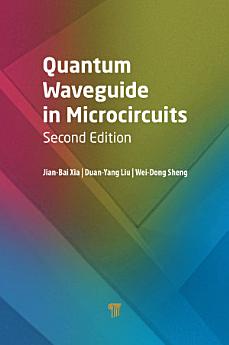Quantum Waveguide in Microcircuits (Second Edition): Edition 2
About this ebook
Physically, when the scale of a circuit element decreases to 10 nm or even less, the quantum effect will appear and play a more and more important role. The electron transport becomes non-classical and non-linear, and even the electron motion likes the waveguide motion. This book introduces some theories and experiments of quantum transport and consists of two parts: (1) Non-Classical and Non-Linear Transport and (2) Quantum Waveguide Theory. It provides some foundations of semiconductor micro- and nanoelectronics for the after-Moore age. The two new chapters in this edition present investigations on (1) mesoscopic transport and (2) Rashba electron’s spin transport in a straight waveguide with a stub that has a smooth boundary.
About the author
Jian-Bai Xia is a professor at the Institute of Semiconductors, Chinese Academy of Sciences, Beijing, China. He has several firsts to his credit. Prof. Xia was the first to propose the plane wave expansion method, tensor model of quantum spheres, effective-mass theory of (11N)-oriented superlattices, and hole tunneling theory. He developed a systematic method in the framework of the effective-mass theory to study the electronic structures of quantum dots and wires in a magnetic or electric field, especially spin-related properties, besides predicting a series of new phenomena relating to quantum dots, quantum wires, and nanofilms. A recipient of many awards and honors, Prof. Xia has published more than 105 articles, authored or coauthored 2 monographs, and served in important capacities in several universities.
Duan-Yang Liu received his BS in applied physics from the College of Science, Tsinghua University, Beijing, China, in 2006 and a PhD in condensed matter physics from the Institute of Semiconductors, Chinese Academy of Sciences, Beijing, China, in 2011. Since 2011, he has been a lecturer in the Physics Department, College of Science, Beijing University of Chemical Technology, Beijing, China. He is currently engaged in research on semiconductor physics, especially carrier transport in low-dimensional semiconductor devices.
Wei-Dong Sheng is a professor in the Department of Physics, Fudan University, Shanghai, China. From 1996 to 1999, he developed systematic transfer-matrix and scattering-matrix approaches to ballistic transport in quantum waveguides and investigated electron waveguide couplers, magneto-transport through edge states, and quantum coherent networks. From 2000 to 2008, he developed a comprehensive framework of numerical approaches to strain distribution, electronic structure, and optical properties of self-assembled quantum dots and is currently engaged in developing an efficient configuration-interaction method for strongly correlated electron systems. Prof. Sheng has held significant positions in many universities.




